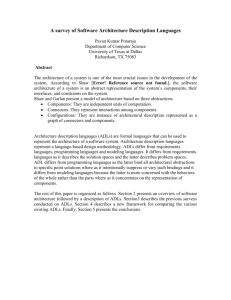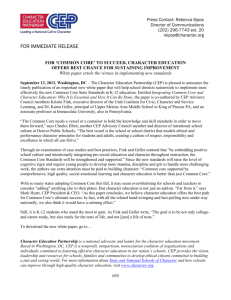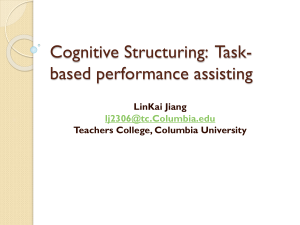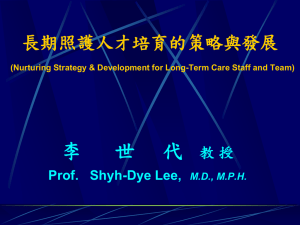Document 13308912
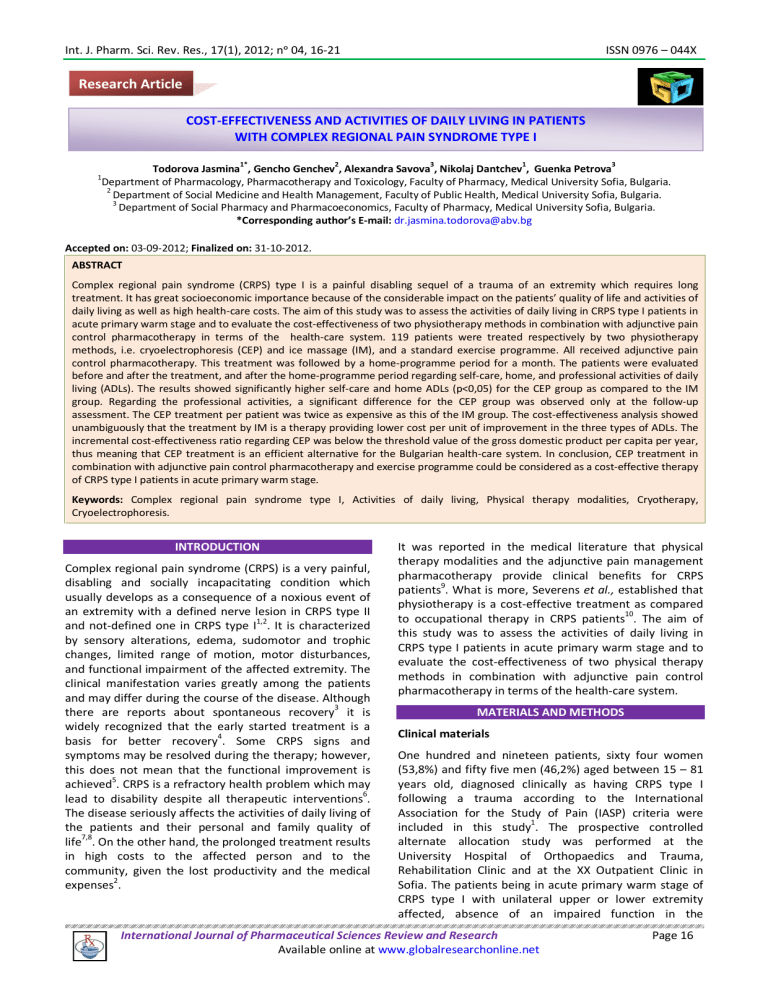
Int. J. Pharm. Sci. Rev. Res., 17(1), 2012; n ᵒ 04, 16-21 ISSN 0976 – 044X
Research Article
COST-EFFECTIVENESS AND ACTIVITIES OF DAILY LIVING IN PATIENTS
WITH COMPLEX REGIONAL PAIN SYNDROME TYPE I
Todorova Jasmina
1*
, Gencho Genchev
2
, Alexandra Savova
3
, Nikolaj Dantchev
1
, Guenka Petrova
3
1
Department of Pharmacology, Pharmacotherapy and Toxicology, Faculty of Pharmacy, Medical University Sofia, Bulgaria.
2
Department of Social Medicine and Health Management, Faculty of Public Health, Medical University Sofia, Bulgaria.
3
Department of Social Pharmacy and Pharmacoeconomics, Faculty of Pharmacy, Medical University Sofia, Bulgaria.
*Corresponding author’s E-mail: dr.jasmina.todorova@abv.bg
Accepted on: 03-09-2012; Finalized on: 31-10-2012.
ABSTRACT
Complex regional pain syndrome (CRPS) type I is a painful disabling sequel of a trauma of an extremity which requires long treatment. It has great socioeconomic importance because of the considerable impact on the patients’ quality of life and activities of daily living as well as high health-care costs. The aim of this study was to assess the activities of daily living in CRPS type I patients in acute primary warm stage and to evaluate the cost-effectiveness of two physiotherapy methods in combination with adjunctive pain control pharmacotherapy in terms of the health-care system. 119 patients were treated respectively by two physiotherapy methods, i.e. cryoelectrophoresis (CEP) and ice massage (IM), and a standard exercise programme. All received adjunctive pain control pharmacotherapy. This treatment was followed by a home-programme period for a month. The patients were evaluated before and after the treatment, and after the home-programme period regarding self-care, home, and professional activities of daily living (ADLs). The results showed significantly higher self-care and home ADLs (p<0,05) for the CEP group as compared to the IM group. Regarding the professional activities, a significant difference for the CEP group was observed only at the follow-up assessment. The CEP treatment per patient was twice as expensive as this of the IM group. The cost-effectiveness analysis showed unambiguously that the treatment by IM is a therapy providing lower cost per unit of improvement in the three types of ADLs. The incremental cost-effectiveness ratio regarding CEP was below the threshold value of the gross domestic product per capita per year, thus meaning that CEP treatment is an efficient alternative for the Bulgarian health-care system. In conclusion, CEP treatment in combination with adjunctive pain control pharmacotherapy and exercise programme could be considered as a cost-effective therapy of CRPS type I patients in acute primary warm stage.
Keywords: Complex regional pain syndrome type I, Activities of daily living, Physical therapy modalities, Cryotherapy,
Cryoelectrophoresis.
INTRODUCTION
Complex regional pain syndrome (CRPS) is a very painful, disabling and socially incapacitating condition which usually develops as a consequence of a noxious event of an extremity with a defined nerve lesion in CRPS type II and not-defined one in CRPS type I
1,2
. It is characterized by sensory alterations, edema, sudomotor and trophic changes, limited range of motion, motor disturbances, and functional impairment of the affected extremity. The clinical manifestation varies greatly among the patients and may differ during the course of the disease. Although there are reports about spontaneous recovery
3
it is widely recognized that the early started treatment is a basis for better recovery
4
. Some CRPS signs and symptoms may be resolved during the therapy; however, this does not mean that the functional improvement is achieved
5
. CRPS is a refractory health problem which may lead to disability despite all therapeutic interventions
6
.
The disease seriously affects the activities of daily living of the patients and their personal and family quality of life
7,8
. On the other hand, the prolonged treatment results in high costs to the affected person and to the community, given the lost productivity and the medical expenses
2
.
It was reported in the medical literature that physical therapy modalities and the adjunctive pain management pharmacotherapy provide clinical benefits for CRPS patients
9
. What is more, Severens et al., established that physiotherapy is a cost-effective treatment as compared to occupational therapy in CRPS patients
10
. The aim of this study was to assess the activities of daily living in
CRPS type I patients in acute primary warm stage and to evaluate the cost-effectiveness of two physical therapy methods in combination with adjunctive pain control pharmacotherapy in terms of the health-care system.
MATERIALS AND METHODS
Clinical materials
One hundred and nineteen patients, sixty four women
(53,8%) and fifty five men (46,2%) aged between 15 – 81 years old, diagnosed clinically as having CRPS type I following a trauma according to the International
Association for the Study of Pain (IASP) criteria were included in this study
1
. The prospective controlled alternate allocation study was performed at the
University Hospital of Orthopaedics and Trauma,
Rehabilitation Clinic and at the XX Outpatient Clinic in
Sofia. The patients being in acute primary warm stage of
CRPS type I with unilateral upper or lower extremity affected, absence of an impaired function in the
International Journal of Pharmaceutical Sciences Review and Research Page 16
Available online at www.globalresearchonline.net
Int. J. Pharm. Sci. Rev. Res., 17(1), 2012; n ᵒ 04, 16-21 ISSN 0976 – 044X contralateral extremity, absence of an infectious or a malignant disease, and not pregnant or lactating for the women were determined as the criteria for inclusion in the study. In order to rule out any other possible cause Xrays were done to all patients. The patients were allocated alternatively with a sequence 2:1 to the study group treated with cryoelectrophoresis according to
Vazharov’s method and the control group treated with ice massage
11
.
Study design
The cryoelectrophoresis was performed by means of the electrotherapy device Polyther-1 of the Bulgarian company Ecomed Services Ltd. The ice electrode was made by freezing two percent sodium chlodide (NaCl) solution with diadynamic biphasic pulsed current, frequency 100 Hz, up to 10 mA flowing through it. The duration of each session was 15 minutes. The control group was treated with an ice massage by means of an ice block over the affected area of the limb with duration of 5 to 10 minutes each session. This treatment was followed by a standard exercise programme immediately after the cryotherapy as well as with a second ice massage to the affected part of the limb up to 5 - 10 minutes and exercises in the evenings. Both groups received these treatment courses of fifteen sessions total for three consecutive weeks, five days a week, one session a day.
The 3-week treatment course was followed by a homeprogramme maintenance period for a month during which all patients had an ice massage with duration of 5-
10 minutes and therapeutic exercises twice a day. All patients from both groups received oral analgesic or nonsteroid anti-inflammatory drugs (NSAIDs) during the
3-week physiotherapy treatment course.
Assessment of the effectiveness transport activities for all patients. The study was approved by the Science Research Council of the Medical
University Sofia.
Cost-effectiveness analysis
The direct health-care cost was calculated as a sum of the costs of the physical therapy methods and the adjunctive pharmacotherapy. The unit prices of the cryoelectrophoresis and the ice massage were gathered from three medical institutions. Those are Medical Centre
Orthomed, Sofia
13
; Specialized Orthopedic Hospital for
Active Treatment Prof. B. Boichev, Sofia and Z.
Cvetanova’s Private Practice, Sofia (the prices were obtained from the tariffs). The average cost per therapy was calculated. For the cost analysis we did not take into account the second ice massage for the days during the treatment course which the patients did as a homeprogramme, neither the ice massage during the maintenance period. Retrospectively, information about the adjunctive pain management pharmacotherapy was obtained from the patients’ records. The oral analgesics and NSAIDs were calculated with respect to their current prices
14
. The exchange rate was 1 Euro = 1,95 BGN. The dynamics of the average values from all assessments in the ADLs charts were taken as a measure of the therapeutic results after the 3-week treatment course and after the home-programme maintenance period. The cost-effectiveness ratio for every improvement in the
ADLs (cost/difference in ADLs dynamics) and incremental cost-effectiveness ratio (difference in cost/difference in improvement in ADLs’ dynamics) were calculated
15
. The robustness of the results was explored through the sensitivity analysis by varying the effect with +/-0,05 around the confidence interval (CI). The number of the patients who completed the study, i.e. 118 was used for the analysis.
The activities of daily living (ADLs) were evaluated with regards to the ability of the patients to perform their selfcare, home, and professional activities. The ADLs dynamics was used as a measure of the therapeutic result. The assessments were done during the patients’ visits before and after the treatment course, and at the follow-up visit after the maintenance period by the standard 6-point scale ranging between 0 (the patient is not able to make the testing activity at all) and 5 (the patient is able to make the testing activity normally). The final assessment mark was calculated as an average value from all marks in the chart. The three types of ADLs for each patient were tested by the charts in Bulgarian language which are standardized and commonly used in the country
12
. Regarding the basic self care ADLs, 12 activities in the bed, 5 activities related to eating, 22 activities related to dressing, and 9 activities about the personal hygiene were evaluated. With regards to the
ADLs at home, 5 related to making the bed, 5 about cooking, 5 related to laundering, and 5 for cleaning were tested. About the professional ADLs, 15 related to the upper extremity and 9 related to the lower extremity were tested respectively to the affected limb, as well as 5
Statistical methods
The statistical analysis was performed by IBM SPSS
Statistics 19.0. The patient characteristics were summarized by a descriptive analysis. One-Sample
Kolmogorov-Smirnov test, test of Shapiro-
Wilk, Independent samples t-test of Student, Two-
Independent-Samples Tests - Mann-Whitney U, One-way
ANOVA, and test for Several Independent Samples of
Kruskal-Wallis were used for the analyses of the ADLs. Ztest for proportions-independent groups was used to test the differences in the pharmacotherapy frequency. The data was considered statistically significantly different if p<0,05.
ADLs dynamics
RESULTS AND DISCUSSION
Of the 119 patients who entered the study 118 completed it. One patient was withdrawn from the control group as he did not complete the 3-week treatment course. As a result, the analysis was based on
75 patients (63,56%) in the study group and 43 patients
(36,44%) in the control group. All patients sustained a
International Journal of Pharmaceutical Sciences Review and Research Page 17
Available online at www.globalresearchonline.net
Int. J. Pharm. Sci. Rev. Res., 17(1), 2012; n ᵒ 04, 16-21 ISSN 0976 – 044X trauma which was of 3 months duration on average. The localization was as follows: distal part of the lower extremity sixty four patients (53,8%), distal part of the upper extremity forty eight patients (40,3%), knee localization in five patients (4,2%), and two patients
(1,7%) had shoulder-hand localization. The dominant extremity was affected in fifty eight of the patients
(48,7%). The professional characteristics of the patients comprised 39 employees (32,8%), 30 workers (25,2%), 44 retired (37%), 3 with private business (2,5%), 2 unemployed (2,5%), and 1 student.
Our results, as seen in table 1, showed that the baseline post-treatment as well as at the follow-up assessments for the patients with lower limb involvement.
The self-care, home and professional activities of daily living were analyzed with regards to the three most represented professional categories among our patients.
As seen in table 3, we did not find any statistical difference between the employees and the workers treated by both methods in the self-care ADLs and the home activities (p>0,05) but their values were significantly higher than these of the retired population
(p<0,05). Regarding the professional ADLs, we could not find a statistical difference among the three professional home ADLs for the study group were significantly higher.
However, there was a tendency of increasing the values groups treated by both methods.
Cost-effectiveness analysis of the three types ADLs for both therapeutic methods with time. The values of the ADLs for the patients from
CEP group were significantly higher after the therapy and
Table 4 summarized the unit prices of both treatment modalities. CEP was slightly more than twice as expensive treatment as IM. The adjunctive oral analgesics or NSAIDs after the home-programme maintenance period as compared to the control group about the self-care and home ADLs (p<0,05). Regarding the professional activities, a significant difference between both groups was pharmacotherapy was prescribed to the patients prior to be referred to physiotherapy and was not changed during the treatment course. The relative share of the prescribed medications did not differ statistically (Table 5). The daily observed only at the follow-up assessment. These regularities were stronger expressed in the analysis on the basis of the upper or lower limb localization as seen in cost of the pharmacotherapy for all patients was higher in the study group including about twice more patients
(Table 6). table 2. About the professional activities, a significant difference between both groups was observed at the
Table 1: Dynamics of the average values of the ADLs for both treatment methods with time
Baseline Post-treatment Follow-up
ADL
CEP IM CEP IM CEP IM
Self-care
Home activities
4,31
3,85*
4,20
3,55*
4,58*
4,23*
4,37*
3,82*
4,82*
4,59*
4,63*
4,13*
Professional activities 3,68 3,70 4,09 3,95 4,47* 4,22*
* There is a significant difference between the values of the ADLs for both treatment methods
Table 2: Dynamics of the average values of the tested ADLs for both treatment methods with time according to the localization
ADLs
Self-care activities
Home activities
Localization
UL
LL
UL
LL
CEP
Baseline
4,03
IM
3,95
4,48
3,39
4,14*
4,43
3,32
3,77*
Post-treatment
CEP
4,42*
4,69*
3,87*
4,46*
IM
4,18*
4,55*
3,60*
4,02*
CEP
Follow-up
4,75*
4,86*
4,38*
4,72*
IM
4,51*
4,75*
3,99*
4,27*
Professional activities
UL 4,04 4,18 4,42 4,39 4,73 4,63
LL 3,46 3,27 3,88* 3,54* 4,31* 3,84*
* There is a significant difference between the values of the ADLs for both treatment methods; UL: Upper limb; LL: Lower limb
Table 3: Comparative analysis between the average values of the three types ADLs’ assessments and the professional categories of the patients*
ADLs
Self-care activities
Home activities
Professional activities
Assessment visit
Baseline
Post-treatment
Employees
n
X
SD n
39 4,38 a
0,33 30
Workers
X
4,35 a
Retired
SD n
X
SD
0,35 44 4,10 b
0,37
Post-treatment 39 4,62 a
0,26 29
1 month follow-up 39 4,82 a
0,19 29
Baseline
4,60
4,82 a a
0,28 44 4,33
0,19 44 4,62 b b
0,39
0,28
39 3,91 a
0,59 30 3,79 ac
0,61 44 3,54 bc
0,49
39 4,23 a
0,53 29 4,21 a
0,54 44 3,86 b
0,46
1 month follow-up 39 4,54 a
0,45 29
Baseline 39 3,70 a
0,57 30
Post-treatment 39 4,07 a
0,50 29
1 month follow-up 39 4,39 a
0,49 29
4,58 a
3,50 a
3,93
4,35 a a
0,35 44 4,21 b
0,53 44 3,83 a
0,47 44 4,10
0,38 44 4,39 a a
0,44
0,64
0,58
0,48
* The same letters on the rows mean that there is no significant difference and the different letters mean that there is a significant difference (p<0,05).
International Journal of Pharmaceutical Sciences Review and Research Page 18
Available online at www.globalresearchonline.net
Int. J. Pharm. Sci. Rev. Res., 17(1), 2012; n ᵒ 04, 16-21 ISSN 0976 – 044X
INN
Table 4: Unit prices of cryoelectrophoresis (CEP) and ice massage (IM)
Medical institution
Specialized Orthopedic Hospital for Active Treatment
Z. Cvetanova’s Private Practice
Medical Centre Orthomed
Average for a procedure
Totally for the treatment course
CEP (in EUR)
5,13
7,69
3,08
5,30
79,50
Table 5: Adjunctive pharmacotherapy
IM (in EUR)
2,57
2,57
2,05
2,40
36,00
Medicine (daily dose)
Ibuprofen 600 mg
Diclofenac 150 mg
Piroxicam 20 mg
Nimezulid 100 mg
Meloxicam 15 mg
Ketoprofen 50 mg
Other
CEP group (% of patients)
21,33 %
37,33 %
18,67 %
9,33 %
5,34 %
8,00 %
0,5%
IM group (% of patients)
20,93%
37,20 %
20,93 %
9,30 %
4,65 %
6,99 %
0,5% z-test for proportion n.s. n.s. n.s. n.s. n.s. n.s. n.s.
Daily dose Cost per day
Table 6: Prices of the oral medications in EUR
Number of patients
Study CEP group
Cost for
20-day therapy
Total pharmacotherapy cost
Number of patients
Control IM group
Cost for
20-day therapy
Total pharmacotherapy cost
Ibuprofen 600 mg 0,23 16 4,60 73,60 8 4,60 36,80
Diclofenac
Piroxicam
150 mg
20 mg
0,17
0,29
27
14
3,40
5,80
91,80
81,20
16
9
3,40
5,80
54,40
52,20
Nimezulide 100 mg
Meloxicam 15 mg
0,35
0,28
7
4
7,00
5,60
49,00
22,40
4
2
7,00
5,60
28,00
11,20
Ketoprofen 150 mg 0,38 6 7,60 45,60 3 7,60 22,80
Total 363,60 204,40
Group
CEP
IM
Cost per patient
84,35
40,75
Table 7: Total cost of the treatment in EUR
Cost of the physical therapy per patient
Cost of the physical therapy for all patients
Adjunctive pharmacotherapy for 20 days for all patients
Average cost of the adjunctive pharmacotherapy per patient for 20 days
Total cost for all patients
Average cost per patient
CEP group
84,348
IM group
5,30 (SD 1,59) 2,40 (SD 0,23)
5962,50 (75 x 79,50) 1548,00 (43 x 36,00)
363,60
4,85 (363,60/75)
6326,10
204,40
4,75 (204,40/43)
1752,40
40,75349
Table 8: Cost-effectiveness analysis (in EUR)
Difference in post-treatment ADLs dynamics
Cost-effectiveness ratio
(cost/difference in ADLs dynamics)
Self-care ADLs Home ADLs Professional ADLs Self-care ADLs Home ADLs Professional ADLs
0,27 0,38 0.41 312,40 221,97 205,73
0,17 0,27 0,25 239,73 150,94 163,01
Table 9: Incremental cost-effectiveness analysis
Treatment group
Cost
Self-care
ADLs
Home
ADLs
Professional
ADLs
IM
CEP
40,75
84,35
0,17
0,27
0,27
0,38
The total cost for the treatment with both physical therapy modalities and the adjunctive pharmacotherapy for the treatment course are presented in table 7. The average total treatment cost per patient from the study group was about twice as high as the one per patient from the control group. The cost-effectiveness analysis
0,25
0,41
ICER for self care ADLs
436,00
ICER for home
ADLs
396,36
ICER for professional
ADLs
256,47
(Table 8) showed unambiguously that the treatment by ice massage was with lower cost per unit of improvement in all three ADLs assessments, i.e. self-care, home, and professional ADLs. For this reason we conducted an incremental cost-effectiveness ratio (ICER) analysis to evaluate the additional cost per additional unit of change
International Journal of Pharmaceutical Sciences Review and Research Page 19
Available online at www.globalresearchonline.net
Int. J. Pharm. Sci. Rev. Res., 17(1), 2012; n ᵒ 04, 16-21 ISSN 0976 – 044X
(Table 9). The ICER regarding CEP modality was below the threshold value of the gross domestic product (GDP) per capita per year, thus meaning that CEP treatment was an efficient alternative for the Bulgarian health-care system.
These results were supported by the sensitivity analysis, presented in figure 1, which was evidentiary that when the effectiveness was changed the ICER did not change in all 3 domains.
700
600
500
400
300
200
100
0
0 2 4
Difference in the effect
6 8
Self-care Home Professional
Figure 1: Sensitivity analysis for all three ADLs assessments
Discussion
Complex regional pain syndrome is a hard-to-treat condition which needs longer medical care and affects the patients’ well-being considerably
16
. Although chronic
CRPS is a tremendous problem for the patients as it results in functional disability
17
, the quality of life and the daily life of the patients suffering acute CRPS are affected as well. ADLs are indicators of disability as they reflect how well a disabled person or someone being treated following an injury can function in the daily life
18
. They are also used to determine the patients’ level of independence and “what skills they can accomplish on their own, as well as to gauge how independent each individual can become after intervention by a health professional”
19
. According to the WHO, as reported by
Geertzen et al., sooner or later these patients “experience skeletal and sensory impairments and experience disabilities that will impact on their performance of activities of daily life”
5
. be reduced with time this does not correlate directly with the functional improvement of the patients . In severely affected CRPS patients only 1 of 5 is fully capable to resume the previous activity
2
.
5,17
Our results from the ADLs’ assessments showed gradual improvement of the ability of the patients from both groups to perform their self-care as well as the home and the professional daily activities but not as quickly as the other signs and symptoms recover. They also showed that the physiotherapy modality CEP improved all three types of ADLs in a greater extent than IM after the treatment and also after the follow-up period. Geertzen et al. found that 62% of the patients had any disability in their 5,5 years follow-up study
5
. Our follow-up was of much less duration and we could not compare our results with theirs, moreover our patients suffered acute CRPS type I.
However, only a small number of our patients fully recovered at the end of our study: 9 patients with an upper limb and 9 patients with a lower limb from the CEP group and 3 patients with an upper limb from the IM group according to their ADLs assessments. Sometimes, the patients have achieved full clinically observed functional recovery but the ADL scores could be low due to the uncertainty of the movements or fear of movement-related pain during the particular testing activity. Another explanation for the low ADL scores for our patients could be that they were accustomed to protect the affected limb and they needed time to change this habit. The fact that there was a statistical difference in the self-care and home ADLs between the working population and the retired patients we suggest could be due to the younger age of the employees and the workers as compared to the retired. The average values of the professional ADLs did not differ among the three social categories which could be explained by the fact that all patients no matter their age had to do certain professionally related activities with the upper or the lower limbs in their everyday life and these activities were impaired and lead to embarrassment.
The primary goals in the multimodal and multidisciplinary therapeutic approach for treatment of CRPS type I are pain relief, functional restoration, and achieving remission
20
. Functional assessment is the method used to document the improvement in the affected functions and the achieved outcomes, with activities of daily living scales being the most frequently used tools
21
. By ADL scales the baseline functional status can be overviewed, activity restrictions can be determined, basis for treatment can be established, intervention programmes can be evaluated, monitoring of the progress can be performed, etc. The performance of the ADLs depends not only on the functional status of the patients but on pain intensity as well. As stated by Geertzen et al., pain is the most important factor which leads to handicap
5
.
Although most signs and symptoms of the condition may
International Journal of Pharmaceutical Sciences Review and Research Page 20
Available online at www.globalresearchonline.net
The unit prices of CEP varied much more among the particular medical institutions as compared to the ones of
IM. As a method, CEP was much time-consuming for the staff and more expensive in terms of resources. A physiotherapist needed about 18 minutes for each session (15 minutes duration of the particular procedure
CEP plus several minutes for preparation: to attach the indifferent electrode, to make ice massage for a minute to the affected area and then to start up the device, and finally to remove the indifferent electrode and to dry the treated limb). Secondly, a special device was needed for
CEP accomplishment and the ice electrode had to be prepared. Thirdly, the physiotherapist had to be trained to perform the procedure. This could explain the fact that the ice massage treatment was with lower cost per unit of difference in ADLs before and after the therapy. The twice higher average cost of cryoelectrophoresis per patient and the slow recovery by both treatment methodologies could explain this result. Analyzing further by the ICER,
Int. J. Pharm. Sci. Rev. Res., 17(1), 2012; n ᵒ 04, 16-21 ISSN 0976 – 044X which provides information about the additional cost paid for every additional improvement by using CEP instead of
IM, it was found that CEP could be considered as a costeffective alternative. The ICER was below the preliminary stated threshold value of GDP per capita. The sensitivity analysis confirmed the robustness of the results.
To our knowledge, the presented study was the first to analyze the cost-effectiveness of these two physical therapy methods for treatment of acute primary warm
CRPS type I patients in combination with adjunctive pharmacotherapy. Further research is needed to support our results.
CONCLUSION
CEP treatment in combination with adjunctive pain control pharmacotherapy and exercise programme could be considered as a cost-effective therapy of CRPS type I patients in acute primary warm stage in terms of the health-care system.
REFERENCES
1.
Merskey H, Bogduk N, Classification of chronic pain: description of chronic pain syndrome and definitions of pain terms, 2nd ed, IASP
Press, Seatle,1994, 40-42.
2.
Oerlemans HM, Oostendorp RA, de Boo T, van der Laan L, Severens
JL, Goris JA, Adjuvant physical therapy versus occupational therapy in patients with reflex sympathetic dystrophy/complex regional pain syndrome type I, Arch Phys Med Rehabil, 81,2000, 49-56.
3.
Zyluk A, The natural history of post-traumatic reflex sympathetic dystrophy, J Hand Surg, 23B, 1998, 20-23.
4.
Perez R, Zollinger P, Dijkstra P, Thomassen-Hilgersom I, Zuurmond
W, Rosenbrand K, Geertzen J, and the CRPS I task force, Evidence based guidelines for complex regional pain syndrome type 1, BMC
Neurology, 10, 2010, 20.
5.
Geertzen JH, Dijkstra PU, van Sonderen EL, Groothoff JW, ten Duis
HJ, Eisma WH, Relationship between impairments, disability and handicap in reflex sympathetic dystrophy patients: a long-term follow-up study, Clin Rehabil, 12, 1998, 402-412.
6.
Kiralp MZ, Dincer U, Cakar E, Dursun H, Complex regional pain syndrome: epidemiologic features, treatment approaches, workday loss and return to work/disability ratios, Turk J Rheumatol, 24, 2009,
1-5.
7.
KemlerMA, Furnee CA, The impact of chronic pain on life in the household, J Pain Symptom Manage, 23, 2002, 433-441.
**********************
8.
Goebel A, Complex regional pain syndrome in adults, Rheumatology,
50, 2011, 1739-1750.
9.
Stanton-Hicks M, Baron R, Boas R, Gordh T, Harden N, Hendler N,
Koltzenburg M, Raj P, Wilder R, Complex Regional Pain Syndromes:
Guidelines for Therapy, Clin J Pain, 14, 1998, 155-166.
10.
Severens JL, Oerlemans HM, Weegels AJPG, van’t Hof MA,
Oostendorp RAB, Goris RJA, Cost-effectiveness analysis of adjuvant physiotherapy or occupational therapy for patients with reflex sympathetic dystrophy, Arch Phys Med Rehabil, 80, 1999, 1038-
1043.
11.
Vazharov J, Kryoelektrophorese-Grundlagen und Ergebnisse nach vierjähriger Anwendung, Z physiother Jg, 42, 1990, 227-232.
12.
Todorov L, Activities of daily living assessment, In: Slanchev P, Bonev
L, Bankov S, editors, Manual for kinesitherapy, Sofia, Medicine and physical culture, 1986,103-106.
13.
http://www.orthomed-bg.com, accessed on July 21, 2012.
14.
http://www.mh.government.bg, accessed on August 28, 2012
15.
Drummond M, O’Brien B, Stoddart G, Torrance G, Methods for the economic evaluation of health care programmes, 2nd ed, Oxford
University Press, Oxford, 1997.
16.
Duman I, Dincer U, Taskaynatan MA, Cakar E, Tugcu I, Dincer K,
Reflex sympathetic dystrophy: a retrospective epidemiological study of 168 patients, Clin Rheumatol, 26, 2007, 1433-1437.
17.
Kemler MA, Furnee CA, Economic evaluation of spinal cord stimulation for chronic reflex sympathetic dystrophy, Neurology, 59,
2002, 1203-1209.
18.
Barbotte E, Guillemin F, Chau N and the Lorhandicap Group,
Prevalence of impairments, disabilities, handicaps and quality of life in the general population: a review of recent literature, Bulletin of the World Health Organization, 79, 2001, 1047-1055.
19.
Activities of Daily Living Evaluation, Encyclopedia of Nursing and
Allied Health, Krapp K ed, Gale Group Inc., 2002, eNotes.com,
Enotes Nursing Encyclopedia, 2006, accessed on August 15, 2012, http://www.enotes.com/activities-daily-living-evaluationreference/activities-daily-living-evaluation.
20.
Stanton-Hicks MD, Burton AW, Bruehl SP, Carr DB, Harden RN,
Hassenbusch SJ, Lubenow TR, Oakley JC, Racz GB, Raj PP, et al., An
Updated Interdisciplinary Clinical Pathway for CRPS: Report of an
Expert Panel, Pain Pract, 2, 2002, 1-16.
21.
Fricke J, Activities of Daily Living, International Encyclopedia of
Rehabilitation, Center for International Rehabilitation Research
Information and Exchange (CIRRIE), accessed on August 15, 2012, http://cirrie.buffalo.edu/encyclopedia/en/article/37/.
International Journal of Pharmaceutical Sciences Review and Research Page 21
Available online at www.globalresearchonline.net
